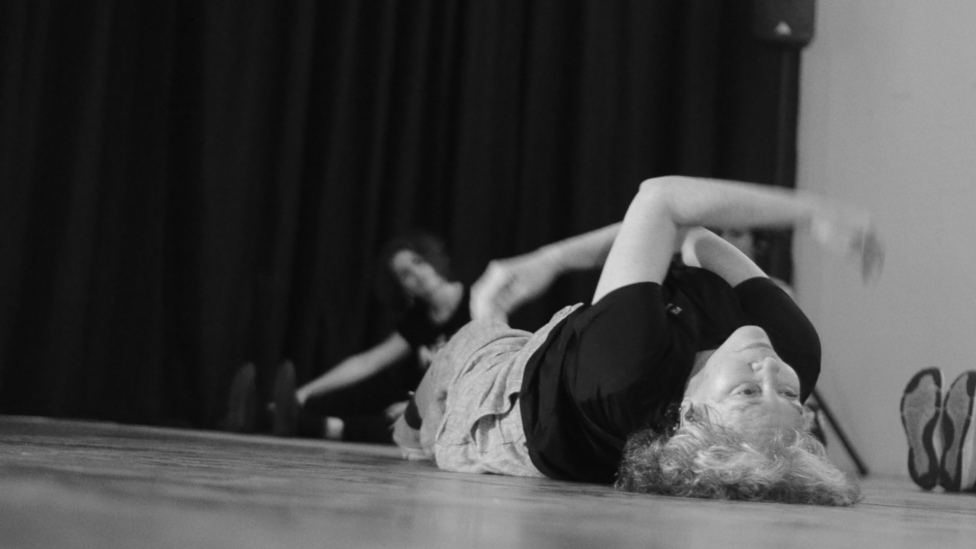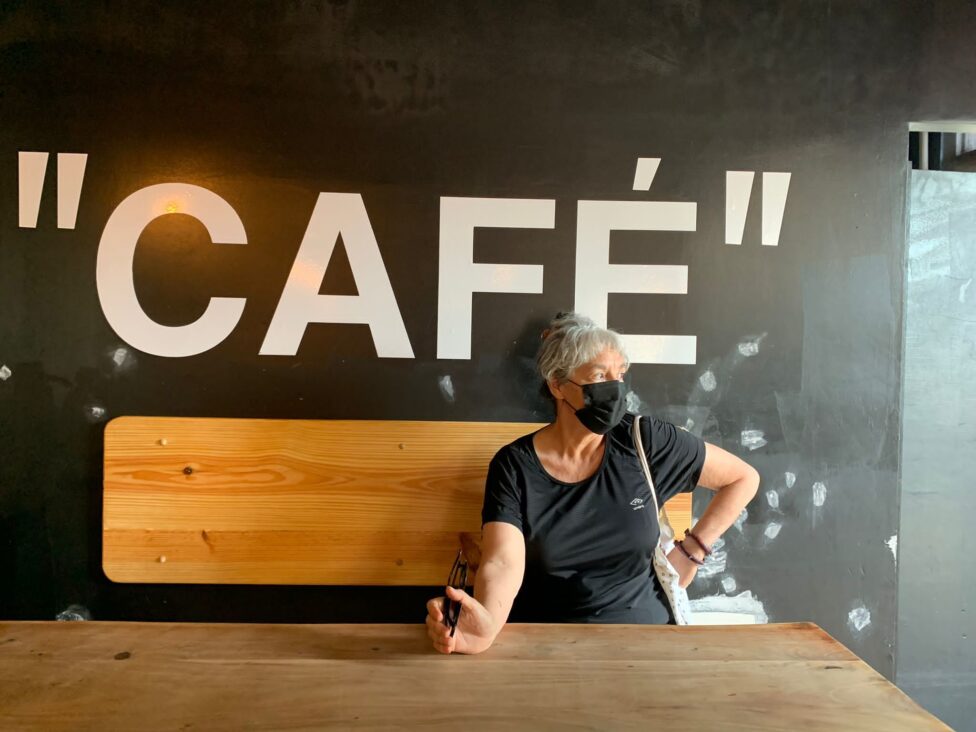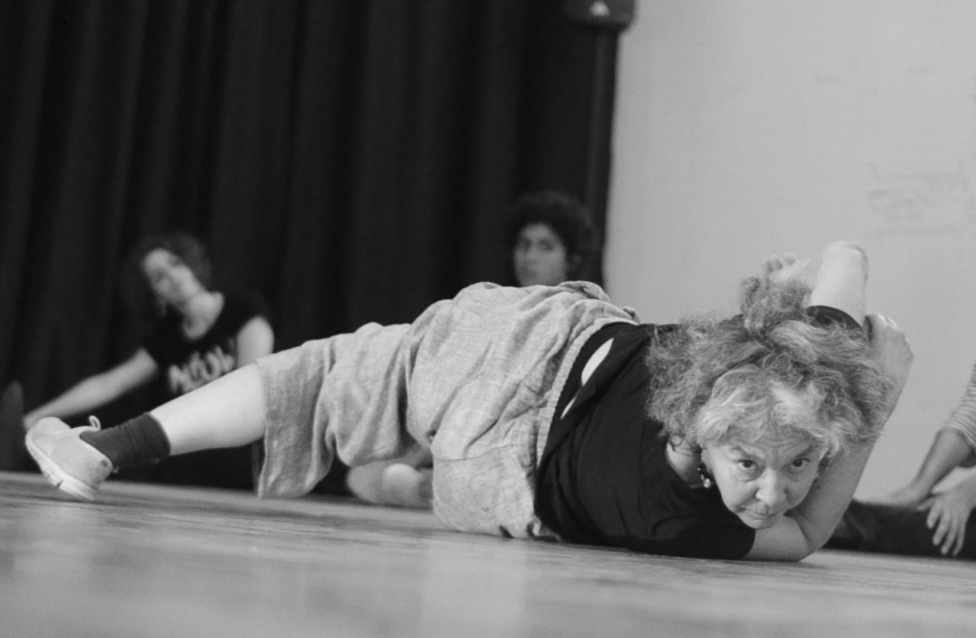Myrna Renaud: I give myself a couple of seasons to focus only on open calls. That for me is an academic task. Yes, that’s what it is.
Nicole Soto Rodríguez: And that is some task, because it takes a lot to spend all that time in front of a computer browsing and selecting.
MR: A lot of screen time, yes. And everything seems to be targeted to emerging artists, everything is for young, up-and-coming artists. Most of what I come across is open calls for new artists that have five years or fewer of experience.
NSR: Five years of experience?!
MR: Of professional experience. Well you know in the end all those open calls are targeted to younger artists. They are for a younger generation. I have been able to express my opinion of this limitation on a couple of those open calls.

Photo by/por Eury G. Orsini.
Still of Myrna giving a demonstration on how to move from the core of the body during floor work for a workshop called “por el suelo”. Part of the event “40 Días de Arte vivo / Taller-instalación de danza plástica” in Taller Libertá, Mayagüez, PR 2019.
[ID: Myrna lays on her back with arms in motion, crossing over her chest. Her white and silver hair rests on the floor. A student can be seen in the the background observing her. Photo by: Eury G. Orsini.]
NSR: You have addressed this in open calls that you have applied to?
MR: Yes, I have.
NSR: I kind of like that. It’s a way of calling them out.
MR: And it also becomes documentation. Documenting the experience.
NSR: Do you do it in the same application?
MR: Yes.
NSR: I like that type of resistance, in a way is letting them know how limiting the open calls can be. So let’s say you apply to an open call for emerging artists: is that where you leave a note? in the same application?
MR: Yes! Pa’ ver … as my Mom would say. Pa’ ver… what it provokes. And it’s really interesting, there is always an abrupt stop to that kind of conversation.
NSR: Has someone ever responded to your note?
MR: Indirectly.
NSR: What does that mean? Do they respond vaguely or just point out the criteria of evaluation for the open call?
MR: No, the criteria is clear from the start.
NSR: What I meant is: where do you leave the note? Because I imagine that they see it once they are evaluating your application. They probably decide to answer by redirecting your note to the criteria—the info on the criteria they had already included in the Open Call description. Which is a way of being polite but not necessarily acknowledging the problem.
MR: It becomes a conversation and it is also evidenced. Well, it becomes evidenced by my note. But yes, everything is targeted for young and emerging artists. To the emergent, to the emergency of the emergent artist. Well… I emerge too you know. Everyday I emerge from my chamber, I look up toward the ceiling, and I say “at it again”.
NSR: Ohh, I ask myself why? It’s curious that in other scenarios or in other ranges of the art world it is the complete opposite. In visual arts the open calls are for artists that are “mid career” or have 15 to 20 years of experience. But it is baffling that in the dance world we are still prioritizing youth.
MR: Well… yes!

Photo by Zuleira Soto-Román.
[ID: Myrna sits at a booth, looking off into the distance. She wears a mask and one hand rests on her hip, her other hand is holding a pair of glasses. Photo by Zuleira Soto-Román.]
NSR: Also, I ask myself: are all of these open calls or opportunities for independent movement artists a new thing? I remember that this was not common a couple of years ago. Everything back then was targeted to ensembles or companies. I suppose that now there are more open calls targeted to choreographers, independent dancers and movement artists because so many people are out of the company structure.
This type of thing has happened to me as well. I once applied to a residency program as a visual artist. In their response, they said I was not selected that year and they added a note suggesting that next time I should consider applying to the open call targeted to dancers. I found this interesting, but it also bothered me. I was applying with a series of video pieces that included an experience of the body. I guess, because it involved the body, I was better suited to a setting related to dance. It’s really interesting how this type of platform handles artists who are between mediums. I’m sure this has happened to you, because you’ve been doing this for a while.
MR: It does happen to me. I have to deal with it day in and day out.
NSR: You have been working with gallery spaces and visual elements for 20 or 30 years now. You started working with storefront showcases or gallery showcases. So if this happens to me—ok—but I do not have 20 or 30 years of experience. It should happen less to you. There is always the limitation of age, from either side, whether you are a young or older artist.
I do think that the dance world is grappling so hard with that age ideal. Young artists are still thought of as the ones capable of moving and having a steady career. For me, it still resembles the traditional structure of a company. The younger dancers are coming in and dancing until they’re 30 and by then, you should be thinking of ways to move onto other scenarios. How does this stand in a world that has changed so much? How are those open calls supposed to be alternatives to independent dancers or movement artists? Many of them are targeted to the independent dancer.
MR: Most of the time, because it’s a big market.
NSR: Exactly.
MR: In much of Europe and Asia, too.
NSR: Asia as well?
MR: Sure, it’s a big thing in Europe and Asia.

Photo by Eury G. Orsini
Still of Myrna giving a demonstration on how to move from the core of the body during floor work for a workshop called “por el suelo”. Part of the event “40 Días de Arte vivo / Taller-instalación de danza plástica” in Taller Libertá, Mayagüez, PR 2019.
[ID: Myrna rolls on her stomach with arms in motion, crossing over her chest. Her gaze is forward. Students can be seen in the the background observing her. Photo by Eury G. Orsini.]
NSR: Then why is age still a category of evaluation? If we already surpassed the ideal of “The Company” why are we still talking about this? What do artists who are 40 or 50 years old and are still working do? I think that is a question for you, how do you do it?
MR: How do we do it?
NSR: How have you done it and continue doing it?
MR: Well, I always visualize what I want. What I desire, what I need, what I wish to accomplish; before starting to work on it. My first action is to believe in what I’m doing and in the piece I’m working on. That is how I start from a place of affirmation: precisely. In that sense I emerge, I affirm myself with those things that I am conscious about and that I have been working for and then, the action of working starts. I’ve never stopped working. I work less now—I work less than I did ten years ago, but I haven’t stopped working. I haven’t stopped producing. I haven’t stopped creating.
And the alliance I have made with younger artists happened naturally with the project ‘La Ruta Cultural’ at the university of Puerto Rico. That was an event in which such trascendental things happened. It really took a turn and became performance, dance and music in a way that hadn’t happened before. It was such a pleasant experience to produce and feel in connection with younger artists, different audiences, and spaces that we visited. Also being able to produce the piece ‘La Rumba de Larvas’ that ended up being the first piece of ‘Cuestión de siete’. Great connections, great stages of creation, sowing stages.
I’ve also accepted and welcomed the pace in which I can produce and work now. My physical range is now a bit conditioned. It’s not as limited as I thought, but is now more conditioned to a visual practice. That is what the Pandemic gave to me.
NSR: To go deeper into visual pieces?
MR: To start designing and playing more with visual explorations. And that’s why I started digital publications. The ones you have been following. On the 1st of November I will release the second volume.
MR: I already have the next two pieces. So in that sense the digital magazine keeps going, but I needed to be in Puerto Rico. I needed to take a break from Lisbon and be in Puerto Rico. But Lisbon, the house, the affection, the bonhomie. The good vibe with the house and my partner. That synchronicity between two people that respect each other and a canary, it was sustenance. Cúrcuma (the Canary) and I did voice work, we worked for two years with sound and voice. So during the pandemic I gave myself time to work on that, with the canary, voice and sound and everything else in the house.
NSR: Time for the ordinary, to be able to withstand the daily routine. Adjusting to the day to day.





